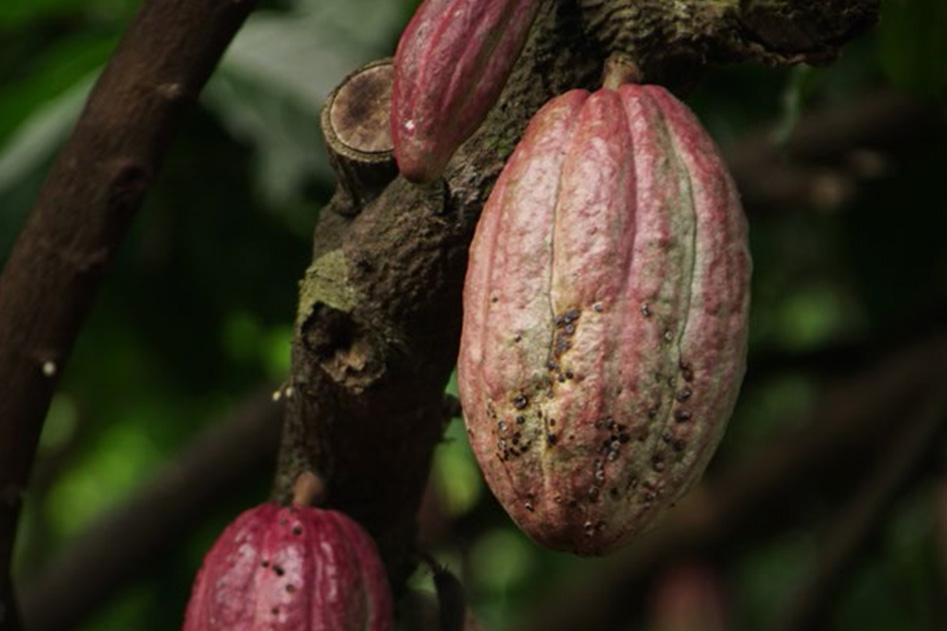
Culture Etc.
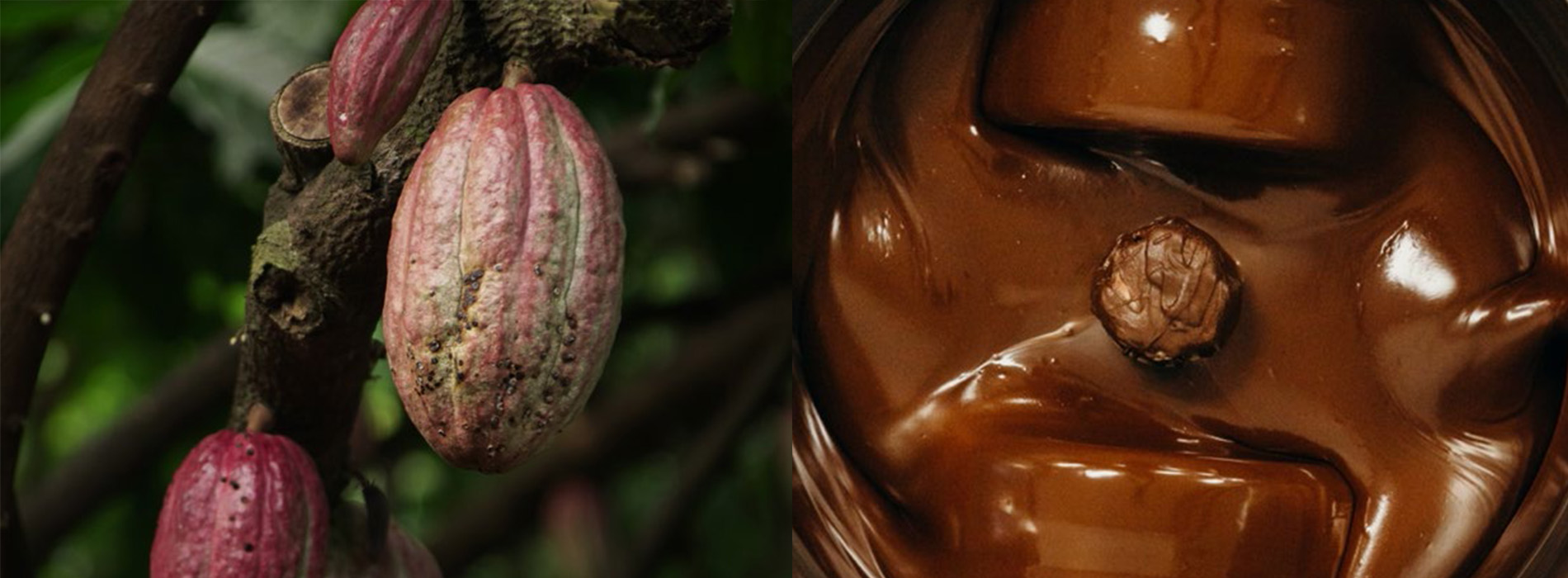
Ripe cocoa pods / liquid chocolate. Photos: Ly Le Minh, Unsplash. Ocho.
The Sweet Science of Making Chocolate
Over the last ten years, New Zealand’s craft chocolate scene has grown enormously. How do these tiny, artisanal makers manage to make a bar worth paying double digits for?
By Laurie Winkless
“Do you ever tire of the aroma?” I ask, staring longingly into a metal vat full of silken, swirling chocolate. “Honestly, I don’t even notice it anymore,” Maddi Brown says, laughing, as she closes the door behind us. “But it’s always the first thing that visitors mention.” Brown has wavy strawberry-blonde hair and light-framed glasses, and she looks surprisingly young for someone who has what is surely a dream job: managing production at the Wellington Chocolate Factory, a bean-to-bar chocolate maker in the heart of the capital.
Over the past decade, there’s been a slow but steady growth in New Zealand’s craft chocolate sector, with an average of one new chocolate maker entering the market each year. While Whittaker’s was for years the king of the local chocolate scene, there are now so many New Zealand-made artisan bars to choose from that you could eat a different one every week for year and still not taste them all. It’s a vibrant scene, and on a mild day in late November last year I dropped by to see Brown, wanting to learn more about how small-scale manufacturers take the hard, fermented seeds (or beans) of a cacao tree, and transform them into chocolate bars with a price tag closer to a bottle of wine than a packet of chips.
It all starts with a quality bean. When I arrived at Wellington Chocolate Factory, several sacks of cacao beans were sitting on a wooden pallet. About 70 per cent of the world’s cacao beans come from four West African countries: Ivory Coast, Ghana, Nigeria and Cameroon. But New Zealand-based makers are increasingly looking to our neighbours in the Pacific for beans, sourcing from places like Papua New Guinea, Solomon Islands, Vanuatu, Samoa and Fiji and, where they can, creating direct relationships with growers.
In these tropical regions, skilled farmers cultivate cacao trees and the iconic hard-shelled pods that grow on them. Brightly coloured, ridged and shaped like a skinny rugby ball, cacao pods are the tree’s fruit. Break one open, and you’ll see its pale pulpy flesh, and buried within that, its precious beans, 20 to 30 per pod. The flavour of raw cacao beans is bitter and intense, but even then, there’s still a hint of the chocolate it will become.
Before the beans arrive in New Zealand, they undergo a fermentation process. To do this, they’re removed from their pods — still encased in pulp — and arranged into dense piles on mats or in large boxes. They’re then covered with leaves, creating a low-oxygen environment where wild yeasts slowly begin to break down the pulp, producing ethanol and other compounds in the process. After about 48 hours, workers ‘turn’ the beans, allowing air to circulate between them. Bacteria then take over the fermentation, which in the course of several days, irreversibly changes the colour and consistency of the beans. Once fully fermented, cacao beans are carefully dried in the sun before being packed into large jute sacks for shipping.
"It looks ready to eat,” I say, salivating behind my face mask. “It still has days to go,” Brown corrects me, but she lets me try it anyway.
For major manufacturers like Cadbury, chocolate-making is a highly industrialised process. It happens across multiple factories filled with complex, noisy equipment, each piece dedicated to a single step in the process. A Cadbury production line in the United Kingdom can churn out a staggering 400 bars a minute. The pace is somewhat slower at Whittaker’s, New Zealand’s largest chocolate company. There, rather unusually for a large manufacturer, the entire journey from bean to bar happens in one facility, and it takes about 24 hours. For craft chocolate producers, that rate of production is still unimaginable. At Wellington Chocolate Factory, for example, a chocolate bar can take four days to make. Artisan-scale manufacturing involves a small team of people (sometimes just a single staffer) using either manual labour or hand-built machines to put the cocoa beans through four key processing steps.
In Wellington, sitting at a stainless-steel bench, two of Brown’s colleagues were carefully sorting through sacks of newly arrived beans, separating them into smaller batches to get them ready for the first step, roasting.
Depending on the factory, cocoa beans are either spread on to trays and stacked into a tall oven, or are loaded into a rotating drum oven. Roasting is a critical part of the process, explains Mike Renfree of Raglan Chocolate. “A huge amount of the flavour development happens in the roasting stage, so getting it right is something I’m continually working on.” The challenge that makers like Renfree and Brown face is that the raw materials are far from uniform. Every harvest is unique, so each batch will have an ever-so-slightly different flavour. Rather than being seen as a problem, that’s part of the charm of eating craft chocolate. “We don’t aim for an identical flavour match,” Brown says. “You’re tasting this specific chocolate, not just ‘chocolate’.” Even so, that variation has an impact on how the beans are treated.
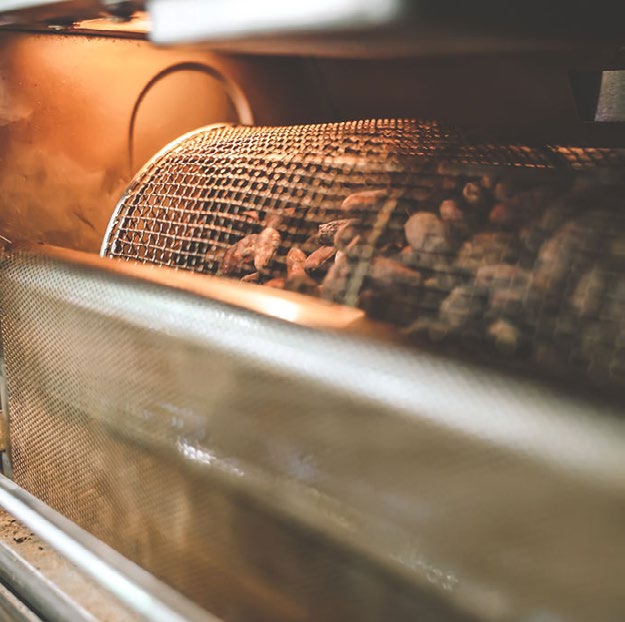
Roasting cacao beans. Photo: Raglan Chocolate.
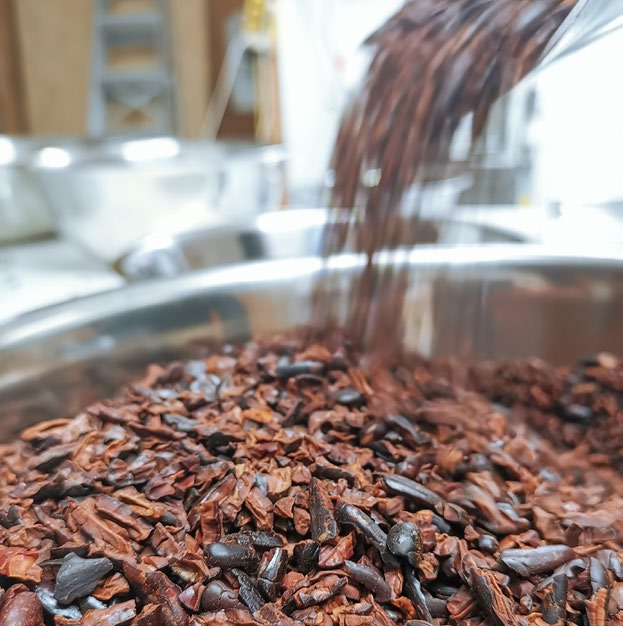
After roasting, the bean’s shell is removed in a process called winnowing, leaving behind pieces of pure cocoa bean, known as ‘nibs’. Photo: Simon Godsiff, Shirl & Moss.
Cocoa beans are roasted at much cooler temperatures than coffee beans, generally between 120–170 degrees Celsius. The ovens start off hot, to ‘shock’ the moisture out of beans and to kill off any microbes present on their surface. The temperature is then progressively lowered over the course of about half an hour. While some makers regularly check roasting progress with an infrared thermometer, their noses play an important role too. “You can smell the whole process,” says Simon Godsiff, who runs the chocolate company Shirl + Moss with his sister, Aimee. “It starts off quite ferment-y but then the aroma starts to turn fudgy. It just progressively gets better and more like chocolate.” Even for a non-expert like me, the transition is apparent. What initially smelled a bit like the whiff of hops on a pale ale gradually lost its astringent notes, transforming into a robust, full-bodied scent.
Next, the beans are sent to the winnower: a machine that crunches and removes their brittle outer shell using rollers and a powerful stream of air. Renfree describes the process as essentially being like “people with baskets repeatedly throwing wheat grain in the air to let the winds carry away the husk”. I’m told that building your own winnower is a rite of passage for chocolate makers. At Raglan Chocolate, Renfree uses a juicer, some plumbing pipes and a vacuum cleaner. What’s left after winnowing is the dense inner cocoa nib, the only part of the bean used to make chocolate. You get about 18 to 20 kilograms of nib from a 30 kilogram batch of beans. The shell is officially a waste product, though it can be (and is) used to make cacao tea and chocolate stout. It’s apparently also a very effective garden mulch.
Depending on the variety of bean, between 30 and 50 per cent of cocoa nib is fat, known as cocoa butter. Grinding, the next processing stage, releases the fat while also steadily decreasing the particle size of the nib solids. Most artisan makers do this in multiple steps, starting with a ‘pre-grind’ that transforms dry chunks of bean into a coarse paste. The paste then needs to go through a much longer grinding step to transform it further into a smooth liquid. In the vast majority of cases, this happens in a melanger — a large, rotating stainless-steel drum that contains a pair of grooved granite wheels turning on a solid granite base. Over the course of many hours, the nib paste will be mixed and squeezed beneath and between the wheels, heating it up and gradually refining and shrinking its particles. By controlling the speed of the drum and the gap between the wheels and the base, a maker can control how finely ground and hot the paste gets.
The molten chocolate Brown showed me during my visit to the factory had been in the melanger for about 24 hours. “It looks ready to eat,” I say, salivating behind my face mask. “It still has days to go,” Brown corrects me, but she lets me try it anyway, finding me a spoon to taste with. I was surprised to find that despite its smooth appearance and unmistakably chocolate flavour, the texture was gritty. Generally, the rule of thumb for artisanal makers is to add ingredients only when they’re a similar particle size to the liquid in the refiner. Typically, it takes 12 to 15 hours before adding the sugar — in most craft chocolate, sugar is the only ingredient added to the cocoa nib. In some recipes, extra cocoa butter — extracted from beans in a separate process — is also added to the drum. To make more complex-flavoured bars, ground hazelnuts, freeze-dried raspberries, peppermint oil or milk powder might be added.
All the while, the grinding and mixing continues, but over the course of several days, the machine settings are slowly adjusted. Though technically still part of the same step, the process is now called ‘conching’, and it is no longer focused on refining particles. Instead, it’s about improving texture and flavour. For texture, the goal is to reduce friction between the particles, which at this stage measure between 25 and 50 micrometres across (about 100 to 200 times smaller than a dried peppercorn). When conching is performed correctly, every particle ends up coated in a layer of cocoa butter, making them ultra-slippery. The flavour development is managed through a combination of airflow and heat. Together, they reduce moisture, and cause the evaporation of certain acidic compounds that would otherwise impart a bitter taste.
“We mainly decide that the process is complete using our senses,” Renfree says. “We look at it and we taste it and check mouthfeel. Sometimes we get the texture right before the flavour is fully there, so if that happens, we’ll leave it in [the drum] for longer.” As an additional step, many craft makers will use a grindometer — a stainless-steel gauge — to check the distribution of particle sizes in their chocolate. Once they’re happy, they move the molten chocolate into the tempering machine for the final step of the process.
If you’ve ever tried tempering chocolate at home, you’ll know how labour-intensive it is. The chocolate needs to be heated and cooled though a series of temperature steps in order to give all of the cocoa butter within it the same crystal form — ‘Type V’, in the parlance of chocolate makers. “Well-tempered chocolate is what we want. It melts near body temperature, has a glossy appearance, and a nice snap when you break it,” says Brown. Even the smallest factories have stopped doing this manually. Instead they use automated tempering machines which can precisely control the temperature of a large vat of molten chocolate, before depositing small quantities of it into the maker’s bar moulds. I watched as Brown’s colleague carefully wrapped a series of cooled, now-solid chocolate bars in their colourful packaging, ready for shipping.
Creativity and artistic instinct can take a craft chocolate maker a long way. But they also rely on a huge amount of scientific knowledge and technical expertise. Jim O’Malley from Dunedin’s Ocho Chocolate has a PhD in pharmaceutical science. Renfree from Raglan Chocolate is both a food technologist and a trained chef. Before moving into the world of chocolate, Brown worked in ice cream, as a research and development technologist at Tip Top.
Ocho produces approximately 6000 bars of chocolate each week. For Wellington Chocolate Factory, the total hovers at around 4000. Shirl + Moss and Raglan operate at a much smaller scale, averaging just a few hundred bars per week each. And while all of these makers seem eager to grow, none see themselves as the next Cadbury. “Our intention is to be a large-volume producer, but without giving up on the essentials,” says O’Malley. “We want to marry the two together — the technology and the craft.” For Godsiff, chocolate making needs “a balance of a technical and creative mindset, which is pretty similar to my work in film and special effects”. Doing it at this scale means getting to do a lot of experimentation, he says. “It is very much my jam.”
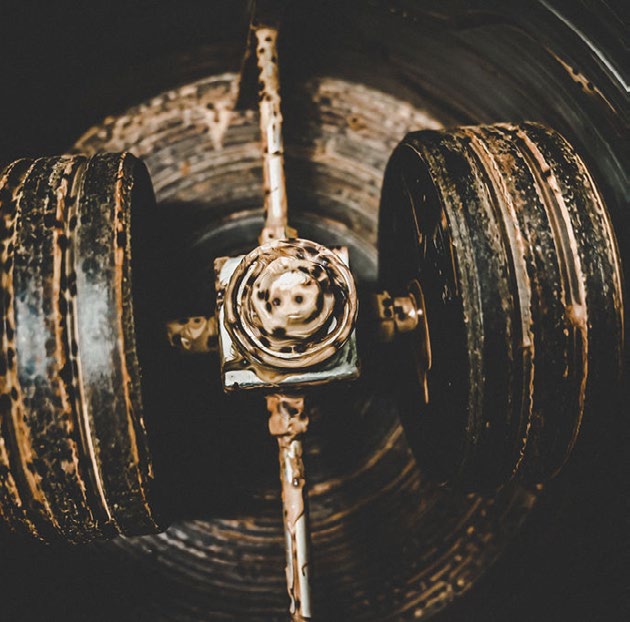
These circular stone grinders work for days refining the paste of cacao and eventually sugar, into a smooth paste. Photo: Raglan Chocolate.

Once cooled, the bars are carefully wrapped. Photo: Simon Godsiff, Shirl & Moss.
Laurie Winkless is a physicist and writer based in Wellington. Her second book, Sticky, delves into the science of friction. She loves chocolate.
This story appeared in the May 2022 issue of North & South.
